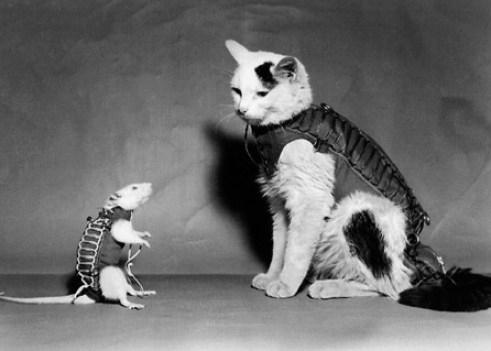Nowadays, the term robot has come to mean a few different things, whether that’s Terminator, a Roomba, or the industrial robots used on manufacturing assembly lines.
Robot means, according to Merriam Webster, “a machine that resembles a living creature in being capable of moving independently and performing complex actions.” Or, on a rudimentary level, “a device that automatically performs complicated, often repetitive tasks.”
But, to really get to the source of the robot definition, we have to take a trip back to 1920, Czechoslovakia.
(Spoiler warning for R.U.R.)
Robot Precursors
Automatons and mechanical human facsimiles have been a part of literature for thousands of years. In Homer’s Iliad, Hephaestus is described as having two golden handmaidens who possessed “intelligence in their hearts.” The handmaidens’ purpose was to hold up Hephaestus’ old, frail body, and not much else.
And we’ve seen a slew of automatons in literature since the classic Greek days. Frank L. Baum’s Tin Man might even be considered an automaton!
But in 1920, the Czech playwright Karel Čapek published his seminal work, R.U.R. (Rossum’s Universal Robots) and effectively solidified the word ‘robot’ into the human lexicon.
R.U.R. In a Nutshell
The premise of Čapek’s play revolves around the idea of a disposable workforce. The main, human characters, work in a factory that produces lifelike robots that are used for all kinds of tasks. Much like our 21st century use of robots—for industry. But, as the play continues, the robots overthrow humanity and essentially become human, capable of thoughts and feelings.
Broken down so simply, R.U.R. reads like the science fiction version of Marx’s Communist Manifesto, with the robots standing in as the proletariat workforce. But, that’s a topic for another time.
Robot Definition as Laid Out by Čapek
The term originated from the Old Slavonic word rabota, meaning “servitude of forced labor,” and in Czech is roboti.
While robot has come to mean a whole slew of things in the modern English language, it’s still rooted in the old Slavonic roots: servitude. Many of our modern robots—the Roomba, for example—don’t have the semi-sentience of Čapek’s robots.
Despite the depictions in the performances of R.U.R.—which show the robots as coated in metal armor with stiff, calculated movements—there are various places in the play where they are said to be near-human, the products of advanced biotechnology.
In the first act, the factory’s general manager, Domain, describes it as the place “where people are made.” And later, one of the characters is revealed to be a robot with much surprise because she was indistinguishable from her human counterparts.
Čapek’s robots are much more advanced than vacuum-bots; in the age of science fiction, we might better describe them as androids. But, the playwright did far more than introduce a popular term into our language, he also pioneered the modern idea of acquired humanity.

Photo from Wikipedia
Years Ahead of His Time
So Čapek gives us the robot definition, but he also presents the notion that artificially-created humanoids might have feelings and the potential for human thought processes. By the end of the play, the robots have taken over the world, but are unable to reproduce or construct new robots.
The big reveal occurs when the robot based off of the human character Helena, and another robot named Primus, come to the conclusion that they “belong to one another,” having somehow discovered emotions and fallen in love. Earlier in the act, the robot Radius explains that the robots have attained humanity, or an accurate imitation of humanity, because they “have read books. We have studied science and the arts. The Robots have achieved human culture.”
As intriguing and advanced as this might have been in 1920, the notion that biologically or mechanically engineered entities can become capable of emotion and human thought is a reality in the modern age.
Great strides in computing have led to deep-learning artificial intelligences that cannot only create their own problem-solving algorithms, but can learn to mimic human emotion.
Mark Riedl, a professor from Georgia Tech with a specialization in AI systems, has been gradually teaching AI common sense and ethics using stories. Much like R.U.R., Reidl is utilizing culture instead of code to teach AI.
Reidl says “When we talk about teaching robots ethics, we’re really asking how we help robots avoid conflict with society and culture at large…. The more an AI system or a robot can understand the values of the people that it’s interacting with, the less conflict there’ll be [and] the more understanding and useful it’ll be to humans.”
And yet, teaching AI and robots via culture poses the question: “Who’s to say that the wealth of sci-fi media that portrays AI as evil won’t bring about our downfall?”
It happens in R.U.R., the culture of “slaughter and domination” precipitates the robots to destroy mankind. Will the human obsession with robot overlords condition our technology to become just that?
Final Thoughts on Karel Čapek’s R.U.R.
We have Čapek to thank for the proliferation of the term ‘robot’, but more importantly, he raised questions about the ethics of robots, androids, and AI.
As we move forward in our pursuit of science, it’s critical that we take a moment to consider the morality of our experiments. That’s why science fiction is such a powerful tool.
R.U.R., Blade Runner, Terminator, etc. show us scenarios of what might happen in the future if we’re not careful today.
Even though the robot definition is steeped in the mindset of servitude, we should strive to create an environment of collaboration, not isolation. Putting the debate over born-humanity and acquired humanity aside, we can make conscious decisions to change the mindset around AI to one of respect and partnership. Who knows, your Roomba might remember the time you kicked it and is harboring a deep resentment, biding it’s time to strike.






